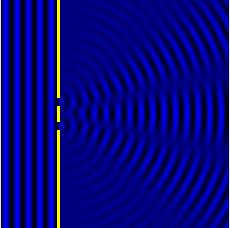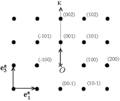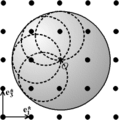Diffraction
Jump to navigation
Jump to search
various phenomena that occur when a wave encounters an obstacle or a slit | |||||
| Upload media | |||||
| Subclass of | |||||
|---|---|---|---|---|---|
| |||||
English: Diffraction
Dansk: Bøjning
Deutsch: Beugung
Français : Diffraction
Suomi: Diffraktio
Español: Difracción
Nederlands: Diffractie
Русский: Дифракция
Drawings[edit]
-
Diffraction disc from a circular aperture
-
Diffraction vector: difference between the wave vector of the scattered wave and the incident wave
-
Structure factor: interferences of waves scattered by the atoms inside the cell
-
Shape factor: interferences of waves scattered by the different cells
-
When the diffraction vector K stays on the same direction, this means that wave vectors of the incidence and scattered waves move symetrically
-
On a single crystal, there is diffraction when the diffraction vector K meet the reciprocal lattice
-
On a powder, there is diffraction when the diffraction vector K meet the sphere formed by the node of all the reciprocal lattice
-
When the incidence wave vector is fixed, the possible diffraction vectors form a sphere called the Ewald sphere or reflection sphere
-
The intersection of the sphere of the nodes of the reciprocal lattice and the Ewald sphere show that the wave vector of the diffused wave whene there is diffraction form a cone
-
Limiting sphere: obtained by the rotation around the origin of the refelction(Ewald) sphere
-
Rotation of the Ewald sphere and Bragg-Brentano geometry (direction of the diffraction vector fixed)
-
Drawing explaining the principle behind two-slit diffraction.
-
Bragg diffraction from a cubic lattice
-
Illustration of two-slit diffraction, based on a sketch by Thomas Young
Photographs[edit]
-
Spectrum from a mercury streetlight diffracted through a compact disc.
-
Diffraction pattern seen in a spiderweb
-
Diffraction angles of a red laser at 600 lines per mm
-
Diffraction waves at ocean surface
-
Diffraction at breakwater
-
CD
-
oil
-
stressed































